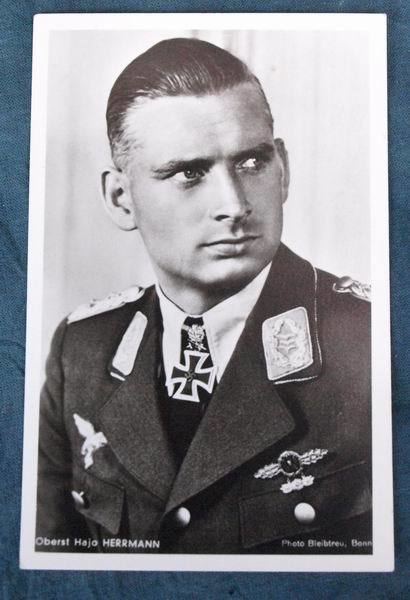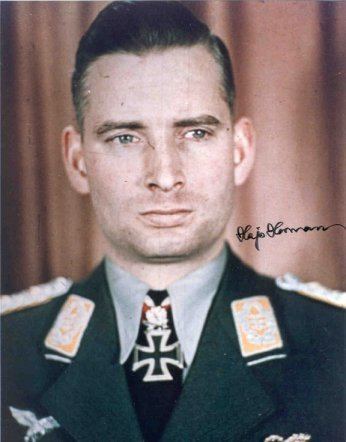Nickname(s) Hajo Commands held 7./KG 4III./KG 30 Books Eagle's wings Unit KG 4KG 30JG 300 | Years of service 1935–45 Name Hajo Herrmann | |
 | ||
Born 1 August 1913Kiel, Germany ( 1913-08-01 ) Battles/wars Spanish Civil WarWorld War IIBattle of BritainBalkans Campaign Died November 5, 2010, Dusseldorf, Germany Battles and wars Battle of Britain, Balkan Campaign | ||
Hajo herrmann me 109 wilde sau
Hans-Joachim "Hajo" Herrmann (1 August 1913 – 5 November 2010) was a Luftwaffe (Nazi German air force) bomber pilot. In World War II, he was a high-ranking and influential member of the Luftwaffe and a recipient of the Knight's Cross of the Iron Cross with Oak Leaves and Swords. The Knight's Cross of the Iron Cross and its higher grade Oak Leaves and Swords was awarded to recognise extreme battlefield bravery or successful military leadership.
Contents
- Hajo herrmann me 109 wilde sau
- Hajo herrmann luftwaffe
- Military career
- Post war activities
- Awards
- References

After World War II Hermann became a lawyer whose high-profile cases included the defense of neo-Nazis and genocide deniers.

Hajo herrmann luftwaffe
Military career

Beginning his military career as an infantry officer, Herrmann was commissioned in the newly formed Luftwaffe in 1935. From 1936 until 1937, he was a bomber pilot in the Condor Legion. During the Spanish Civil War, Herrmann joined KG-4. When World War II began, he flew bombing missions into Poland and Norway. By 1940, he was Commander of the 7th Staffel of KG 4 and took part in the Battle of Britain. In February 1941, his group went to Sicily, from where it attacked Malta and Greece. In one attack, Herrmann dropped a bomb on an ammunition ship, the SS Clan Fraser; the explosion sank eleven ships and made the Greek port of Piraeus unusable for many months. In early 1942, he was commander of III./KG 30, attacking Arctic convoys from Norway, including the attacks on Convoy PQ 17. In July 1942, he was assigned to the general staff in Germany, where he became a confidant of Hermann Göring, the head of the Luftwaffe. During his career as a bomber pilot, Herrmann flew 320 operational sorties and sank 12 ships totalling 70,000 tons.

In 1942, Herrmann was appointed to the Luftwaffe Operational Staff. Gaining a reputation as a tactical and operational innovator, he was the creator of the Luftwaffe night fighter wing Jagdgeschwader 300, which was a response to the night raids of Royal Air Force (RAF) Bomber Command on Germany in mid-1943. The RAF had achieved ascendancy over the Nachtjäger radar-guided night fighter forces, through the use of the radar countermeasure Window and Herrmann suggested that experienced night flying pilots and ex-instructors be equipped with Fw 190 Wilde Sau (Wild Boar) day fighters and hunt the bombers by the light of the fires below and with the aid of special 'flare-carrier' Junkers Ju 88s following the bomber streams. He also called for the use of the Naxos radar detector units on some of these single engined fighters, to locate bombers using H2S. Herrmann flew more than 50 night fighter missions and claimed nine RAF bombers destroyed. Although JG 300 and subsequent units had promising initial success, the wastage of pilots and aircraft due to high accident rates curtailed extensive use of Wilde Sau beyond the start of 1944.
In December 1943, Herrmann was appointed Luftwaffe Inspector of Aerial Defence. By 1944, he was Inspector General of night fighters and received the Knight's Cross with Oak Leaves and Swords. At the end of 1944, he led the 9. Flieger-division (J). At this time he was a leading exponent of the tactical deployment of Rammjäger Sonderkommando Elbe (ram fighters, task force Elbe), sent into action in April 1945. Pilot volunteers, often aged 18 to 20, were to be trained only to be competent enough to control specially lightened and unarmoured Bf 109 fighters and bring down Allied bombers by ramming the tail or control surfaces with the propellers of their aircraft and bailing out if possible. Herrmann's intention was to gather a large number of these fighters for a one-off attack on the USAAF bomber streams, hopefully causing enough losses to curtail the bombing offensive for a few months. Fuel shortages prevented employment of the large numbers necessary, although from one mission of this type, on 7 April 1945, of the 120 planes thus committed only 15 came back.
Post war activities
Herrmann was captured by the Soviets after the war and was held prisoner for ten years before returning to Germany in 1955. Once back, he studied law and settled in Düsseldorf. He defended Otto Ernst Remer, the head of the neo-Nazi Socialist Reich Party and the genocide deniers David Irving and Fred A. Leuchter. In 1959, Herrmann married the German soprano Ingeborg Reichelt and the couple had two children.
